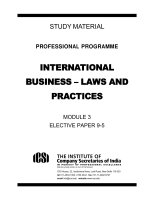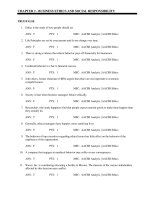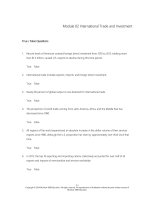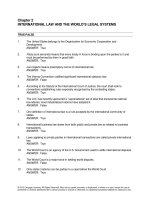International business law and practices
Bạn đang xem bản rút gọn của tài liệu. Xem và tải ngay bản đầy đủ của tài liệu tại đây (5.02 MB, 486 trang )
STUDY MATERIAL
PROFESSIONAL PROGRAMME
INTERNATIONAL
BUSINESS – LAWS AND
PRACTICES
MODULE 3
ELECTIVE PAPER 9-5
ICSI House, 22, Institutional Area, Lodi Road, New Delhi 110 003
tel 011-4534 1000, 4150 4444 fax +91-11-2462 6727
email website www.icsi.edu
i
© THE INSTITUTE OF COMPANY SECRETARIES OF INDIA
TIMING OF HEADQUARTERS
Monday to Friday
Office Timings – 9.00 A.M. to 5.30 P.M.
Public Dealing Timings
Without financial transactions – 9.30 A.M. to 5.00 P.M.
With financial transactions – 9.30 A.M. to 4.00 P.M.
Phones
41504444, 45341000
Fax
011-24626727
Website
www.icsi.edu
Laser Typesetting by AArushi Graphics, Prashant Vihar, New Delhi, and
Printed at Tan Prints
ii
INTERNATIONAL BUSINESS - LAWS AND PRACTICES
Today globalization has dramatically re-shaped the markets and has changed the way business is being done.
One has to keep pace with the customer’s requirement and has to bring in services and products as per global
standards. International trade has become a vital component of development strategy, which can be used as an
effective instrument of economic growth. Moreover the establishment of institutions like World Trade Organisation
has ushered a new era of global economic co-operation reflecting the widespread desire to operate in a more
open multilateral trading system. Participation in international trade has become necessity for all countries and
as well as companies for growth.
Thus it becomes important for professionals to acquire knowledge and skill to help work in international companies
and in global environment. Having updated knowledge of international business laws and procedures becomes
key requisite for professionals. So, in this study broad aspects related to international business environment,
export management, FDI policy, FTP policy, international trade theories, international trade bodies like WTO,
UNCTAD, international logistics and supply chain etc. has been discussed in detail. Added emphasis has been
laid on strategic alliances, foreign collaborations and joint ventures abroad, to enable the students to discharge
efficient services and to tackle practical situations.
In this study every efforts has been made to give a comprehensive coverage of all the topics relevant to the
subject. At the end of each study lesson a brief about the lesson have been given under the caption ‘Lesson
Round Up’ as well as questions have been given under the caption ‘Self Test Questions’ for the practice of
students to test their knowledge.
This study material has been published to aid the students in preparing for the INTERNATIONAL BUSINESS –
LAWS AND PRACTICES paper of the CS Professional Programme. It is part of the education kit and takes the
students step by step through each phase of preparation stressing key concepts, pointers and procedures.
Company Secretaryship being a professional course, the examination standards are set very high, with emphasis
on knowledge of concepts, applications, procedures and case laws, for which sole reliance on the contents of
this study material may not be enough.
Therefore, in order to supplement the information/contents given in the study material, students are advised to
refer to the Suggested Readings mentioned in the study material, Student Company Secretary, Business Dailies
and Journals.
In the event of any doubt, students may write to the Directorate of Academics and Perspective Planning in the
Institute for clarification at or
Although due care has been taken in publishing this study material yet the possibility of errors, omissions and/
or discrepancies cannot be ruled out. This publication is released with an understanding that the Institute shall
not be responsible for any errors, omissions and/or discrepancies or any action taken in that behalf.
Should there be any discrepancy, error or omission noted in the study material, the Institute shall be obliged if
the same are brought to its notice for issue of the corrigendum in the Student Company Secretary bulletin.
iii
SYLLABUS
ELECTIVE PAPER 9-5 : INTERNATIONAL BUSINESS - LAWS AND PRACTICES
Level of Knowledge: Expert Knowledge
Objective: To acquire specialized knowledge in International business, law, procedure and practices.
Detailed Contents:
1. Introduction
– International Business - Nature and Scope,
– Globalization - Meaning, Levels, Merits, Limitations and irreversibility of Globalization
– Need to go global
– Internationalization Decisions (entry modes)
– SEZ features
2. International Business Environment
– Meaning of Environment
– Dimensions - PEST to STEEPLE
– Internal Environment and External Environment
– SWOT Analysis
– Various approaches to Assess competitiveness including Michael Porter’s 5- Forces Model
– Global Competitiveness Index
3. Multi National Enterprises (MNEs) and Foreign Direct Investment (FDI)
– Meaning and Characteristics
– Role of MNEs in host economy
– Trends in Global FDI
– Trends in FDI with reference to India
– Issues with MNEs - Taxation, Restrictive Trade Practices, Currency, Jurisdiction and Technology Transfer
4. Foreign Trade Policy and Procedures
– Introduction to Foreign Trade Policy
– Institutional Framework for Export Promotion
– Export Incentives and Facilities
– EPZ/FTZ/100% EOUs
– Quality Control for Exports
– Export Prospects for Select Products and Services
– INCO Terms
iv
– International Commercial Arbitration-Shipment and Post Shipment Finance
– SEZ-Incentives and Benefits
– Method of Realizing Export Payments and Ensuring Guaranteed Export Payment
– Central Excise Clearance Formalities
– Customs Regulations and Clearance Formalities for Exports & Imports
– Duty Draw Back Claims Procedure
– Foreign Trade Financing - Export & Import
– Foreign Exchange Risk Management
– International Credit Management
– Warehousing
– Instruments of Trade Policy and India’s Trade Policy
5. International Trade and Regional Economic Integration
– Theory - Mercantilism, absolute advantage and comparative advantage
– Trends in Global Trade
– Trends in India’s Trade
– Types of Regional Economic Integration - Free Trade Area, Custom Union, Common Market, Economic
Union, Monitory Union and Political Union etc.
– Trading Blocks- ASEAN,SAFTA,SAARC,NAFTA,EU
6. Institutional Environment
– Pre WTO Scenario, difference between GATT and WTO
– Trade Related Institutions - WTO and UNCTAD
– WTO - Basic Principles, various agreements, Functions and Areas of Operations, Dispute Settlement
Mechanism (rules and procedures)
– IMF, IBRD, ADB
– Commodity Agreements
7. Anti-Dumping Duties
– WTO Provisions on Anti-Dumping-, Anti-Dumping Duties, Procedure and Developments
– Regulatory Framework for Anti Dumping in India
– Recent Anti Dumping Cases in India
8. Subsidies and Countervailing Duties
– WTO Provisions
– Administration
– Procedure and Emerging Trends
– Regulatory Framework for Subsidies & Countervailing duties in India
– Doha Development Round
v
9. Foreign Collaborations and Joint Ventures
– Foreign Direct Investment Policy, Industrial Policy
– Kinds of Collaboration and Joint Ventures
– Drafting of Agreement
– Restrictive Clauses in the Foreign Collaboration/Joint Venture Agreements
– International Commercial Arbitration
10. Strategic Alliances
– Meaning, Rationale, Types, Trends in Alliances in New Competitive Environment, Strategic Alliance
Failures, Managing Strategic Alliances.
11. Logistics Management
– Logistics Framework- Concept, Objective and Scope
– Transportation, Warehousing, Inventory Management, Packing and Unitization, Control and
Communication
– Role of IT in Logistics, Logistics Service Firms and Third Party Logistics
vi
LIST OF RECOMMENDED BOOKS
MODULE 3
ELECTIVE PAPER 9-5 : INTERNATIONAL BUSINESS - LAWS AND PRACTICES
The students may refer to the given books and websites for further knowledge and study of the subject :
Books :
– International Trade and Export Management by Francis Cherunilam , Himalaya publishing House
– International Business by K Awasthappa, Mc Graw Hill
– Foreign Trade Policy and Handbook of Procedures by R.K.Jain (17th Edition 2012)
– Anti Dumping Law and Procedures by R.K.Gupta (4th Edition 2013)
– International Business – Justin Paul, PHI Publications
– A Guide to Export-Import Consultancy & Registration Services V.K.Pamecha, Paper Bac
– Export Management, P.K.Khurana, Paper Back
Websites :
– www.wto.org
– www.imf.org
– www.adb.org
– www.unctad.org
– www.worldbank.org
– www.finmin.nic.in
– www.commerce.nic.in
– www.saarc-sec.org
– www.iccwbo.org
– www.rbi.org.in
– www.asean.org
– www.europa.eu
– www.sapta.co.in
– www.naftanow.org
vii
CONTENTS
INTERNATIONAL BUSINESS - LAWS AND PRACTICES
LESSON 1
INTRODUCTION TO INTERNATIONAL BUSINESS
Business
2
International Business
2
Drivers of International Business
2
Benefits of International Business
4
Scope of International Business
5
Difference between Domestic and International Business
5
Globalisation
8
Benefits of Globalisation
9
Criticisms of Globalisation
10
Myths about Globalization
10
Stages of Globalisation
11
Risks in Global Business
13
Issues in Global Business
13
Globalisation and International Trade
14
Globalisation and Financial Markets
15
Globalization, Income Inequality and Poverty
15
Globalisation and Strategic Management
16
The Future of Globalization
18
India and Globalisation
18
Needs to go Global
22
From an individual company’s viewpoint
22
From the governments viewpoint
23
Modes of Entry and Operation in International Business
24
Exporting
25
Licensing
25
Franchising
26
Special Modes
28
Foreign Direct Investment without Alliances
29
Foreign Direct Investment with Strategic Alliances
30
viii
Page
LESSON ROUND UP
30
SELF TEST QUESTIONS
31
LESSON 2
INTERNATIONAL BUSINESS ENVIRONMENT
Concept of International Business Environment
34
Internal and external environment
34
Economic Environment
36
Technological Environment
39
Political – Legal Environment
40
Socio-Cultural Environment
42
Global Environment
43
Physical Environment
44
Tools for Environmental Analysis
44
Pest Analysis
44
PEST Analysis Template
47
PESTEL Model
50
SWOT Analysis
51
SWOT Analysis Template
54
Porter’s Five Forces model
57
Global Competitiveness index
61
The 12 Pillars of Competitiveness
62
The Global Competitiveness Index of India 2012–2013
67
LESSON ROUND UP
68
SELF TEST QUESTIONS
69
LESSON 3
MULTINATIONAL ENTERPRISES (MNEs) AND FOREIGN DIRECT INVESTMENTS (FDI)
Multinational Enterprises/Multinational Corporations
72
Characteristics of Multinational Corporations
73
Forms of Multinational Corporations
74
Role of Multinational Corporations
75
Benefits to Host Country
75
Benefits to Home Country
76
ix
Page
Criticism of Multinational Corporations
76
Issues with Multinational Corporations
77
Foreign Direct Investment
78
Importance of FDI
79
Advantages of FDI
80
Disadvantages of FDI
80
Trends in global FDI
80
FDI trends in INDIA
87
Industrial policy of India
90
Industrial Policy Resolution, 1948
91
Industrial Policy Resolution, 1956
91
New Industrial Policy, 1991
92
FDI Policy Framework in India
92
Role of Department of Industrial Policy & Promotion
93
FDI Policy of India
94
Key Changes in Consolidated FDI Policy 2013
103
Foreign Investment Implementation Authority (FIIA)
111
FDI Policy: The International Experience
112
Cross-Country Comparison of FDI Policies
115
LESSON ROUND UP
118
SELF TEST QUESTIONS
118
LESSON 4
FOREIGN TRADE POLICY AND PROCEDURES PART I – EXPORT PROMOTION
Introduction
122
Foreign Trade Policy 2009-14
123
Export promotional measures
127
Assistance to States for Developing Export Infrastructure and Allied Activities (ASIDE)
127
Market Access Initiative (MAI)
127
Market Development Assistance (MDA)
128
Meeting Expenses for Statutory Compliances in Buyer Country for Trade Related Matters
128
Towns of Export Excellence (TEE)
128
Brand Promotion and Quality
129
x
Page
Test Houses
129
Quality Complaints/Disputes
129
Trade Disputes affecting Trade Relations
129
Export and Trading Houses
129
Focus Market Scheme (FMS)
130
Focust Product Scheme (FPS)
130
Duty Exemption & Remission Schemes
130
Advance Authorisation Scheme
131
Duty Free Import Authorisation Scheme
131
Export Promotion Capital Goods Scheme
131
Export Oriented Units
131
Special Economic Zones
134
Setting up of SEZ
137
Free Trade and Warehousing Zones
138
Facilities available in a FTWZ
139
Some FTWZ in India
140
Institutional Framework for Promotion of Exports
140
Ministry of Commerce
141
Autonomous Bodies/ Public Sector Undertakings/ Export Promotion Councils/other Organizations
under Ministry of Commerce
144
Commodity Boards
144
Marine Products Export Development Authority, Cochin
145
Agricultural and Processed Food Products Export Development Authority, New Delhi
145
Export Inspection Council
145
Indian Institute of Foreign Trade, New Delhi
146
Indian Institute of Packaging, Mumbai
146
Public Sector Undertakings Ministry of Commerce
146
State Trading Corporation of India Limited (STC)
146
MMTC Limited
147
PEC Limited
147
Export Credit Guarantee Corporation of India Limited (ECGC)
147
India Trade Promotion Organization (ITPO)
148
Export Promotion Council
148
xi
Page
Registered Export Promotion Councils
149
EPCS under the Administrative Control of the Department of Commerce
149
Other Organisations under Ministry of Commerce
151
Federation of Indian Export Organisations
151
Indian Council of Arbitration, New Delhi
152
Indian Diamond Institute, Surat
152
Footwear Design & Development Institute (FDDI)
152
National Centre for Trade Information
152
Price Stabilization Fund Trust
153
GS1-India
153
Advisory Bodies
153
Board of Trade (BOT)
153
Terms of reference of the Board of Trade
153
Inter State Trade Council
154
Attached and Subordinate Offices
154
Directorate General of Foreign Trade (DGFT)
154
Directorate General of Supplies and Disposal (DGS&D)
154
Directorate General of Anti-Dumping & Allied Duties (DGAD)
154
Directorate General of Commercial Intelligence and Statistics (DGCI&S)
155
Offices of Development Commissioner of Special Economic Zones (SEZs)
155
Pay and Accounts Office (Supply)
155
Pay and Accounts Office (Commerce & Textiles)
156
Exim Bank of India
156
LESSON ROUND UP
158
SELF TEST QUESTIONS
159
LESSON 5
FOREIGN TRADE POLICY AND PROCEDURES PART II – EXPORT MANAGEMENT
Concept of Export
162
Reasons for Export
162
Planning for Export
162
Product Selection
163
Market Selection
164
xii
Page
General Provisions Regarding Imports and Exports
165
Registration of Exporters
165
Registration with Reserve Bank of India (RBI)
165
Registration with Director General of Foreign Trade (DGFT)
165
Registration with Export Promotion Council
165
Registration with Commodity Boards
166
Registration with Income Tax Authorities
166
Importer Exporter Code Number (IEC)
166
Export License
170
Inquiry and Offer for Exports
171
Sample Exports
171
Export Pricing
172
Incoterms
173
Export Documents
175
Pre-shipment Documents
176
Post-shipment Documents
176
Documents Related to Goods
177
Documents Related to Payment
178
Documents Related to Inspection
178
Documents Related to Excisable Goods
179
Certificates Related to Shipment
179
Terms of payment or methods of payment
180
Payment in advance
181
Open account
181
Documentary collections
182
Documents Against Payment (D/P)
183
Documents Against Acceptance (D/A)
183
Letter of credit
184
Parties to Letters of Credit
185
Types of Letter of Credit
189
Export Financing
190
Pre-shipment / Packing Credit
192
Stages of Granting Pre Shipment Credit to Exporter
193
xiii
Page
Types of Pre-shipment Rupee Export credit
194
Rupee Export Packing Credit to Manufacturer Suppliers
194
Rupee Export Packing Credit to Sub-Suppliers
194
Rupee Pre-shipment Credit to Construction Contractors
194
Pre-shipment Credit to Floriculture, Grapes and Other Agro-based Products
195
Packing Credit Facilities to Deemed Exports
195
Pre-shipment Credit in Foreign Currency (PCFC)
196
‘Post-shipment Credit’
197
Types of Post Shipment Rupee export credit
197
Export Bills Purchased/ Discounted (DP & DA Bills)
197
Export Bills Negotiated (Bill under L/C)
197
Advance against bills for collection
198
Advances against Undrawn Balances on Export Bills
198
Post-shipment Advances against Duty Drawback Entitlements
198
Advances against Retention Money
198
Advance against export on consignment basis
198
Post-shipment Credit In Foreign Currency
199
Factoring and Forfaiting
199
Export Factoring
200
Forfaiting
201
Quality Control & Pre-shipment inspection
203
Documents Required for Quality Control & Pre-shipment Inspection
204
ISI Certification
204
Agmark Certification
204
In-Process Quality Control (IPQC)
204
Self-Certification Scheme
205
ISO 9000
205
Packaging
205
Labeling
206
Central Excise Clearance Procedure for Export
206
Procedure for Export to all Countries (Except Nepal and Bhutan) under Payment of Duty
206
Procedure for Export to all Countries (Except Nepal and Bhutan) without Payment of Duty
208
Customs Procedure for Export
210
xiv
Page
Export Risk Management
213
Types of Risks
213
Methods and Instruments to Manage Risks
213
Forfaiting
214
Hedging
214
Export Credit Insurance
215
Export Credit Guarantee
216
LESSON ROUND UP
217
SELF TEST QUESTIONS
219
LESSON 6
INTERNATIONAL TRADE AND REGIONAL ECONOMIC INTEGRATION
International Trade – Meaning
222
Difference between International and Domestic Trade
222
Reasons for International Trade
222
Theories of International Trade
224
Mercantilism
224
Theory of Absolute Advantage by Adam Smith
225
Theory of Comparative Advantage by David Ricardo
225
Hecksher Ohlin Model
227
New Trade Theory: by Paul Krugman
227
Recent Trends in Global Trade
228
India’s Trade Performance
230
Regional Economic Integration
240
Regional Trading Blocs
241
Types of Regional Trading Blocs
241
Advantages of Regional Trading Blocs
242
Disadvantages of Regional Trading Blocs
242
Association of South-East Asian Nations (ASEAN)
243
European Union
245
North American Free Trade Agreement (NAFTA)
248
South Asian Association for Regional Cooperation (SAARC)
250
South Asian Preferential Trading Area
252
xv
Page
South Asian Free Trade Area (SAFTA)
252
LESSON ROUND UP
255
SELF TEST QUESTIONS
255
LESSON 7
INSTITUTIONAL ENVIRONMENT
World Trade Organization
258
Principles of the Trading System
259
History and Formation of WTO
261
GATT: ‘Provisional’ for Almost Half a Century
261
The Tokyo Round: A First Try to Reform the System
262
Did GATT Succeed?
263
The Uruguay Round
263
A Round to End all Rounds?
264
What happened to GATT?
265
The Post-Uruguay Round Built-in Agenda
265
How is the WTO Different From GATT?
266
Dispute Settlement Mechanism
266
WTO Structure
271
WTO Secretariat
272
The WTO Agreements
272
1. Agreement on Tariffs
273
2. The Agriculture Agreement
274
3. Agreement on Standards and safety
274
4. Agreement on Textiles
275
5. Agreement on Trade in Services
276
6. Agreement on Intellectual Property
277
7. Agreement on Safeguards
279
8. Agreements on Non-tariff Barriers: Red Tape, Etc
281
9. Agreement on Plurilaterals
282
10. Agreement on Trade Policy Reviews
283
United Nations Conference on Trade and Development (UNCTAD)
285
Members
285
xvi
Page
UNCTAD Conferences
287
History of UNCTAD
287
Main Goals
289
Main Activities
290
Relationship with other Agencies
291
UNCTAD and civil society
291
UNCTAD´s Programme Budget and Financing of Technical Cooperation Activities
292
Evaluation at UNCTAD
292
International Commodity Agreements
293
International Buffer Stock Agreements
293
International Export Quota Agreement
294
International Grains Agreement
294
International Coffee Agreement
295
International Tropical Timber Agreement
295
International Cotton Advisory Committee
295
International Cocoa Agreement
296
International Sugar Agreement
296
World Bank
296
Members
296
Organisation
297
Functioning of the World Bank
297
Contributions of the World Bank
297
India and the World Bank
298
International Monetary Fund (IMF)
301
Fast Facts on the IMF
302
Goals of IMF
302
Surveillance
302
Financial assistance
303
SDRs
303
Technical assistance
303
Resources
303
Governance and organization
303
India and the IMF
304
xvii
Page
Asian Development Bank
304
Members
305
Regional Members
306
Nonregional Members
307
Board of Governors
308
Board of Directors
308
Management
308
Policies and Strategies
308
History
308
Working of ADB
309
India and ADB
310
LESSON ROUND UP
312
SELF TEST QUESTIONS
313
LESSON 8
ANTI DUMPING DUTIES
Dumping
316
Anti Dumping
316
Difference between Anti Dumping duty and Normal Customs duty
316
WTO – Provisions on Anti Dumping
316
Article VI of GATT and the Anti-Dumping Agreement
317
Anti-Dumping Agreement
318
Basic principles of the Anti Dumping Agreement
318
Committee on Anti-Dumping Practices
318
Dispute settlement
319
Notifications
319
Dumping
319
Determination of Normal Value
320
Determination of Export Price
321
Calculation of Dumping Margins
322
Refund or Reimbursement
323
Determination of Injury and Casual Link
323
Like Product (Article 2.6)
323
xviii
Page
Injury
324
Types of injury
324
Basic Requirements for Determination of Material Injury
324
Basic Requirements for Determination of Threat of Material Injury
325
Elements of Analysis
325
Consideration of Volume Effects of Dumped Imports
325
Consideration of Price Effects of Dumped Imports
325
Evaluation of Volume and Price Effects of Dumped Imports
325
Examination of Impact of Dumped Imports On the Domestic Industry
325
Demonstration of Causal Link
326
Cumulative Analysis
326
Investigation
326
Initiation
326
Conduct
326
Provisional Measures and Price Undertakings
327
Imposition of Provisional Measures
327
Price Undertakings
327
Collection of Duties
327
Imposition and Collection of Duties
327
Retroactive Application of Duties
327
Review and Public Notice
328
Duration, Termination and Review of Anti-Dumping Measures
328
Public Notice
328
Regulatory Framework for Anti Dumping in India
328
Legal Framework
329
Institutional Arrangement in India for Anti Dumping
329
Anti Dumping Duties – Procedures in India
329
Recent Anti Dumping Cases in India
337
Case Study
340
The Indian Shrimp Industry Organizes to Fight the Threat of Anti-Dumping Action
340
LESSON ROUND UP
346
SELF TEST QUESTIONS
347
xix
Page
LESSON 9
SUBSIDIES AND COUNTERVAILING DUTIES
Subsidy
350
Difference between Dumping and Subsidy
350
Countervailing Duty
350
Anti Dumping Duty and Countervailing Duty
350
WTO Provisions on Subsidies and Countervailing Duties
351
Agreement on Subsidies and Countervailing Measures
352
Structure of the Agreement
352
Definition of Subsidy
353
Definition of Specificity
354
Categories of Subsidies
354
Countervailing Measures
356
Parameters Determining Countervailing Measures
357
Determination of Injury
357
Definition of Injury
357
Causal Link
358
Assessment of Subsidy
358
Guidelines for Determination of Subsidy
358
Transition Rules and Special and Differential Treatment
358
Notification
359
Countervailing Legislation and Measures
359
Dispute Settlement
359
Procedural Matters
359
Making an Application for Investigation into Countervailing Measures
359
Time-Limit to Conduct the Investigation
360
Transparency in Investigation Process
360
Manner under which the Investigation is Conducted
361
Legal Framework with Respect to Imposition of Anti-Subsidy In India
361
Implementing Authorities in India
361
Doha Development Round
362
Recent Case Studies
364
xx
Page
LESSON ROUND UP
366
SELF TEST QUESTIONS
366
LESSON 10
FOREIGN COLLABORATIONS AND JOINT VENTURES
Foreign Collaboration
368
Examples of Foreign Collaboration
369
Features of Foreign Collaboration
370
Objectives of Foreign Collaboration
371
Types of Foreign Collaboration
372
Foreign Collaborations in India
373
Foreign Technology or Technical Collaborations in India
373
Joint Venture
376
Reasons for Forming a Joint Venture
378
Basic Elements of a Joint Venture
378
Structuring the Joint Venture
379
Managing the Joint Venture
380
Modes of Joint Venture
381
Equity Joint Venture
381
Contractual Joint Venture
381
Advantages of Joint Venture
383
Disadvantages of joint venture
384
Termination of Joint Ventures
384
Examples of Joint Ventures
385
Joint Venture Agreements
386
Drafting of a Joint Venture or Foreign Collaboration Agreement
390
Specimen Joint Venture Agreement
391
Joint Ventures Abroad by Indian companies
395
International Commercial Arbitration
399
Benefits of International Commercial Arbitration
400
LESSON ROUND UP
402
SELF TEST QUESTIONS
403
xxi
Page
LESSON 11
STRATEGIC ALLIANCES
Introduction
406
Meaning and Definition
407
Advantages of Strategic Alliances
407
Disadvantages of Strategic Alliance
408
Types of Strategic Alliances
408
Strategic Alliance on the basis of Type of Industry
408
Strategic Alliance on the basis of Capital Commitments
408
Stages of Alliance Formation
409
Reasons for Creating Strategic Alliances
409
Managing Strategic Alliances
411
Strategic Alliance Failures
413
Trends in Strategic Alliances
415
Case Studies
415
LESSON ROUND UP
418
SELF TEST QUESTIONS
418
LESSON 12
LOGISTICS MANAGEMENT
Logistics Management – Meaning and Definition
422
Objective of Logistics Management
423
Role of Logistics Management in an Organization
424
Stages in Logistics Management
424
Scope of Logistics Management
425
Transportation
426
Components of Transportation Network
426
Types of transport modes
426
1. Air
427
2. Sea
427
3. Rail
427
4. Road
428
xxii
Page
5. Pipeline
428
Transport provides
429
(1) Common & Private Carriers
430
(2) Freight Forwarders
430
(3) Third Party Logistics (3PL) Providers
430
3PL Industry in India
432
Fourth Party Logistics Providers (4PL)
433
Warehousing
434
Types of warehouses
434
Role of IT in Warehousing
436
Advantages of IT Warehousing
436
Warehouse Management Systems
437
Barriers to IT Adoption in Warehousing
438
Warehousing in India
439
Warehouse (Development and Regulation) Act, 2007
439
Logistics Park
440
Free Trade Warehousing Zones (FTWZ)
440
Central Warehousing Corporation (CWC)
441
Inventory Management
442
Packaging
443
Packaging Types
443
Containerisation/Unitization
444
Container
445
Types of Containers
445
Container Unit - ‘Teu’ Twentyfoot Equivalent Unit
447
Container Seal Numbers
447
Concepts of FCL & LCL
447
Procedure for Selection of the Container
447
Container Ship
448
Container Yard (CY)
448
Container Terminal
448
Sequence of Operations & Documentation Procedures in Container Terminal
448
Benefits of Containerisation
449
xxiii
Page
Containersation in India
449
Container Corporation of India Ltd.
449
Control and Communication
450
The Role Information Technology in Logistics
450
Emerging Trends in Application of IT for Logistics Management
452
LESSON ROUND UP
453
SELF TEST QUESTIONS
454
TEST PAPERS
Test Paper 1/2013
459
Test Paper 2/2013
460
Test Paper 3/2013
461
xxiv
Lesson 1
Introduction to International Business
Lesson 1
Introduction to International Business
LESSON OUTLINE
LEARNING OBJECTIVES
– Business
Globalisation is the order of the day with most
countries eliminating trade barriers and paving
the way f or gr owth and expansion of
international business. During the last 15
years, world exports for goods have grown
on average 6% a year. International business
has become lifeline of every economy and
country. For countries to flourish economically
it is very important for them to encourage
international business. T he benefits of
international busines s are im m ens e.
International business when undertaken with
spec ific obj ec tives by c om panies and
promoted by governments of nations can lead
to overall economic growth of the world at
large. Every corporate and government has
numerous and concrete reasons to take their
busines s inter national. However it is
necessary to keep in view various limitations
of the globalisation also.
– International business
– Drivers of international business
– Benefits of international business
– Scope of international business
– Difference between domestic and
international business
– Globalization
– Meaning of globalisation
– Benefits of globalisation
– Criticisms of globalisation
– Myths about globalisation
– Risks in global business
– Issues in global business
– Globalisation and international trade
– Globalisation and financial markets
In this chapter we will learn about globalisation
its positive and negative impacts and how
globalisation of economy is taking place. There
are different methods of entering foreign
markets such as exporting, licensing,
franchising, FDI, management contracts and
turnkey projects. The choice of method of entry
would depend on the long term corporate
strategy taking into consideration various
environmental factors in the host country and
home country.
– Globalisation, income inequality, and
poverty
– The future of globalisation
– Needs to go global
– Modes of entry and operation in
International Business
– LESSON ROUND UP
– SELF TEST QUESTIONS
“Globalisation is creating rich countries with poor people.”
Joseph Stiglitz
1
1









